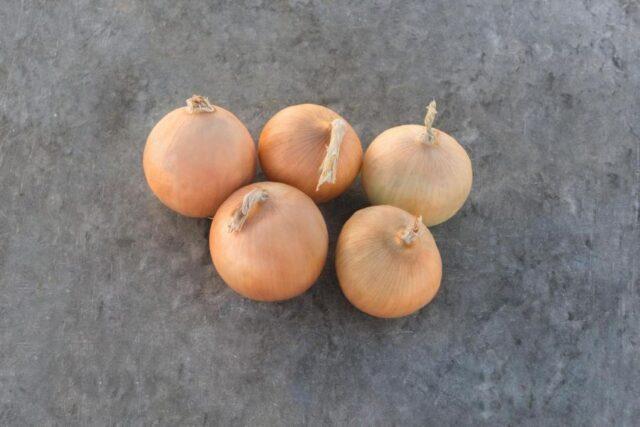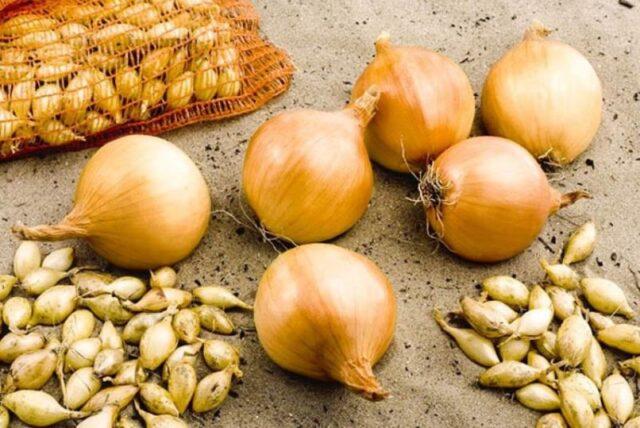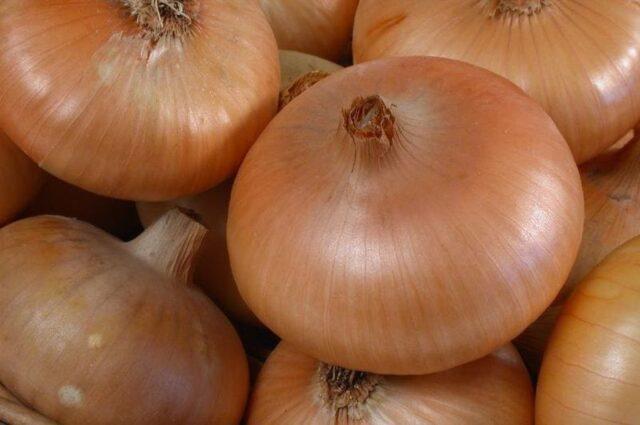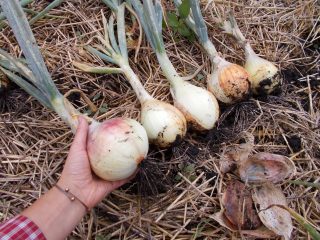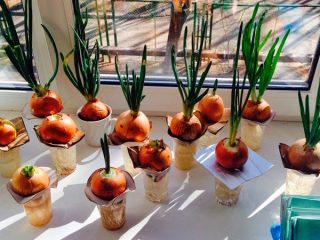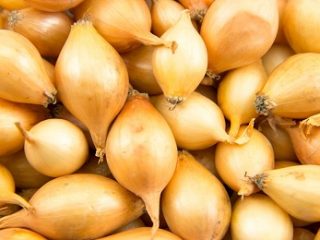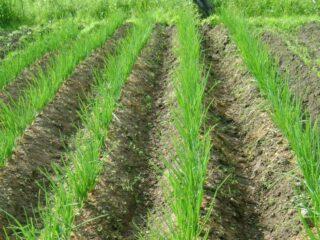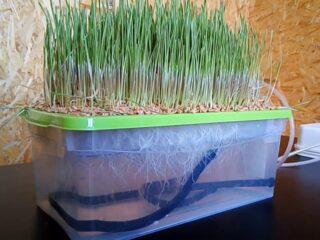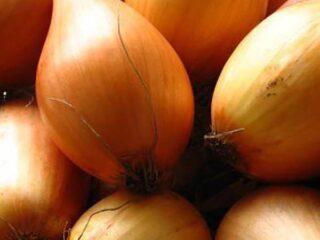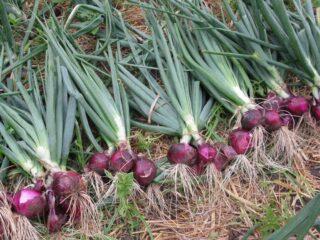Content
The onion shoots - many gardeners face this problem and end up not getting the expected harvest. Meanwhile, the germination of peduncles is caused by specific reasons that can be completely prevented.
Consequences of shooting a bow
If the onion releases an arrow, this means that the vegetable has entered the first phase of reproduction. After the shoot grows, an inflorescence will appear at its end, and then the seeds will begin to ripen.
Shooting onions poses a threat to the crop. Since the plant directs all nutrients to the formation of seeds, underground turnips become smaller and shriveled, dry out and become unsuitable for consumption.
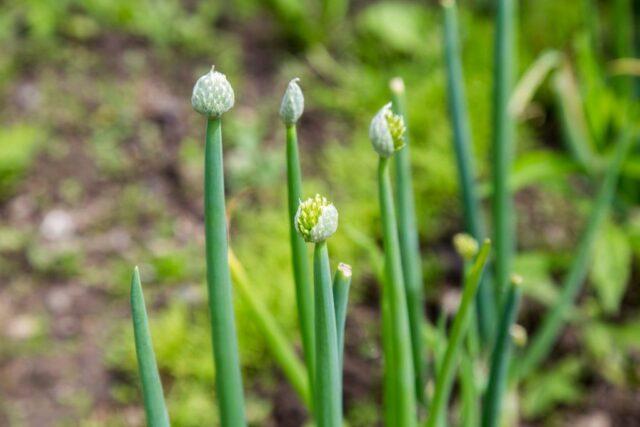
Flower-bearing onion arrows are suitable for consumption along with feathers
Why did the bow go into arrow?
Vegetable bolting is caused by several specific reasons. If you know what triggers the regrowth of flowering shoots, the situation becomes easier to prevent.
Improper storage
Onion shoots often begin due to improper winter storage of the sets.Planting material must be kept in a dry, dark and fairly cool room at a temperature of 0 to 20 °C.
If the onion is stored indoors at 28 °C or higher, the air humidity is more than 80%, and sunlight falls on the set, growth processes will begin under the husk. Immediately after planting in the garden, the vegetable will begin to bolt, and it will not be possible to get a decent harvest from it this season.
Failure to comply with planting deadlines
Onions often shoot when planted in the ground too early or too late. It is necessary to transfer the seedlings to the garden at the moment when the ground warms up to 10-15 °C. It is usually recommended to plant onions in late April or early May to prevent shoots.
Violation of the watering regime
Onions are relatively drought-resistant and do not die when there is insufficient rainfall. However, moisture deficiency provokes bolting. In dry soil, the bulbs immediately proceed to the propagation stage and produce flowering shoots without releasing green feathers.
During the first stages of growth, it is necessary to water the crop beds twice a week. The soil should always remain slightly moist; a dry, hard crust should not be allowed to form on the surface of the earth. At the same time, you should not flood the plantings either, otherwise the roots of the turnips will begin to rot, and you still won’t be able to wait for the harvest.
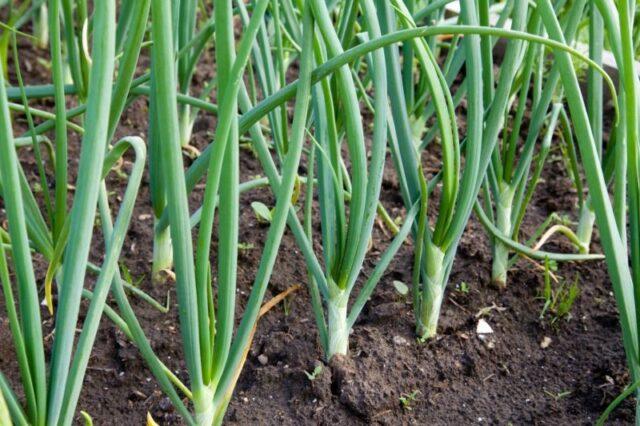
About a month before harvest, watering is stopped completely so that the onions stop growing feathers.
Poor quality planting material
Shooting of onions often occurs when using too large a set.The larger the turnip, the higher the likelihood that it will produce a flower stalk after planting.
You can grow onions without arrows by using small sets no larger than 3 cm in diameter, slightly larger in size than a walnut. To further check the turnip for quality, you need to lightly squeeze it with your fingers. A good set, not prone to bolting, hard, does not collapse, but does not crunch either. The husk on it should be healthy and shiny.
Other reasons
Onions shooting in the garden can be caused by several other reasons. In particular:
- Wrong choice of variety. Onions with golden skins are least susceptible to bolting. Red and purple varieties produce flower stalks much more often, even if all growing rules are followed.
- Harvesting too late. If the seeding was removed from the garden late, then the bulb, while in the soil, probably began to store nutrients, prepare for wintering in open ground and grow additional roots. In the spring, such planting material is likely to give rise to shoots.
It is necessary to harvest onions from the beds at the end of summer after the green feathers have died. In dry weather, turnips are often left to ripen for about a week without being removed from the garden. However, the connection between the roots and the soil must first be broken so that the plant’s growing season stops.
What to do if the bow goes into the arrow
In some cases, the vegetable begins to shoot, even if all precautions have been taken. The appearance of flower stalks does not always mean the death of the crop.The arrows can be cut off in a timely manner, in which case the bow will be able to return to growing feathers and forming an underground turnip. It is necessary to walk around the beds with crops every day - this will allow you to notice unwanted flower stalks in time.
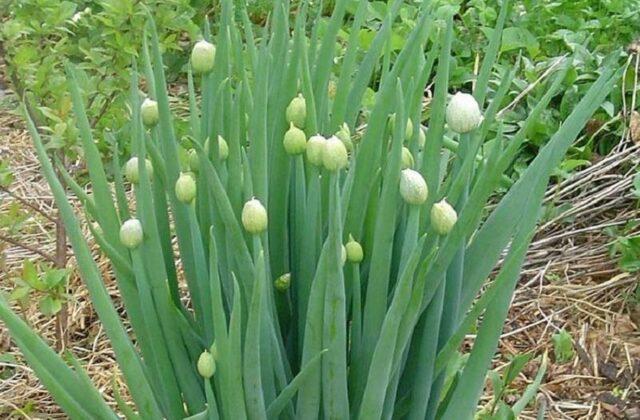
The arrows are cut off after the shoot reaches 20-30 cm in height
If a vegetable sown in the spring or an onion planted before winter has gone into arrows, it is impossible to trim the shoots with a metal tool. The peduncle is torn off with your hands, and not at the very surface of the earth, but with an indentation of 4-5 cm. Viruses and bacteria can enter the plant through a fresh wound. If the scrap is located above ground level, the likelihood of vegetable contamination will be reduced.
It is not necessary to throw away torn flower stalks. Since they are completely edible, they can be added to a salad or stew, fried with vegetables, or frozen for the winter in a plastic bag.
What to do to prevent the bow from shooting
Shooting onions causes inconvenience, so it is better, in principle, to prevent the crop from growing flower stalks. There are several ways to do this.
Soak
You can plant onions so that there are no shoots after soaking. The seeds must be treated in a saline solution prepared at the rate of 15 g of powder per 1 liter of water. The bulbs are dipped in liquid for 2-3 hours, and then laid out to dry on a paper towel. Soaking will not only help prevent bolting, but will also further strengthen the plants’ immunity.
Warming up
Warming up the planting material provides good bolting prevention. Onion sets should be poured onto a sheet of thick paper and placed on a sunny windowsill or on a radiator for a week.If the planting material was stored in violation of the recommendations, was frozen or damp, then the warming up time is increased to two months.
Hardening
Hardening off the planting material helps improve the germination of onions and prevent bolting. It is carried out according to the following algorithm:
- The seeds are immersed in water at a temperature of about 45 °C for 15 minutes.
- After the expiration date, transfer the bulbs to cold liquid for ten minutes.
- Dry the material on paper towels.
The procedure must be carried out immediately before sowing the vegetable, so that immediately after hardening it can be transferred to the garden.
Smoke treatment
To prevent onions from going into arrows, the sets can be pre-treated with smoke. In a remote corner of the garden, you need to light a fire, wait until it burns down to coals, and then hang nets with planting material over it.
Leave the sevok over the rising smoke for 20 minutes. After treatment, the likelihood of bolting will decrease, and in addition, resistance to fungal diseases will increase.
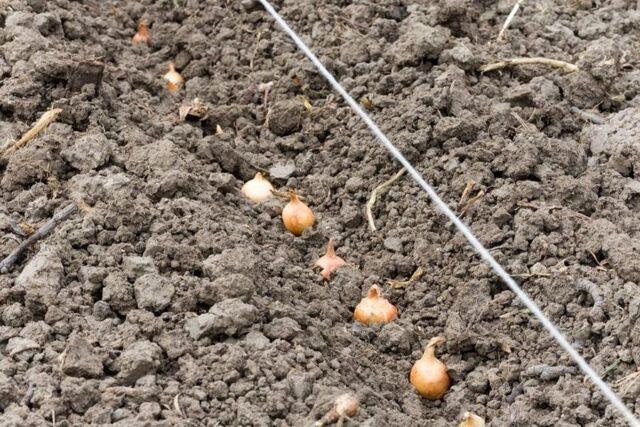
Onions produce arrows less often when sowing in winter in cold soil
Non-shooting onion varieties
The most reliable way to avoid bolting is to plant in your summer cottage those plant varieties that, in principle, do not produce flowering shoots or produce them much less frequently. There are several varieties of this onion:
- Radar. A Dutch onion variety with rounded fruits reaches 300 g in weight. Covered with a yellowish husk, the flesh is white and has a very pungent taste.
Onion Radar is suitable for autumn planting
- Troy. The popular variety rarely produces flower stalks; onions without arrows can be planted in winter and spring.The turnips of this variety are round, neat, with a golden husk, the pulp has a moderately pungent taste.
Troy onion sets are stored for about four months
- Myachkovsky. Dark brown onions with flat-rounded fruits reach 120 g in weight. It has good keeping quality and is suitable for growing as turnips and feathers.
Myachkovsky onions have an islandy but mild taste
Varieties of shallots are resistant to bolting. Such plants produce juicy greens and compact but tasty turnips. It is very convenient to obtain high-quality sets from shallots, since its fruits are naturally divided into cloves during development.
Conclusion
Onions go to waste due to the wrong time for planting, when using low-quality sets or when storage conditions are violated. Peduncles can be cut off in time and the harvest can be saved, but it is better to prevent the plant from entering the reproduction phase at all.
